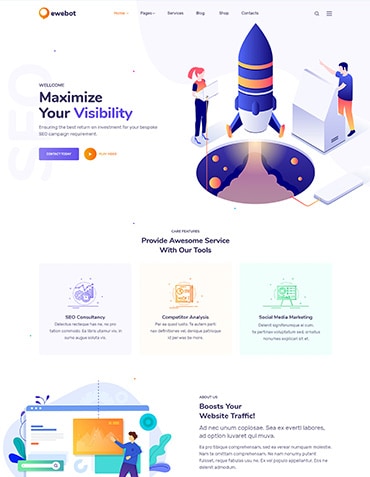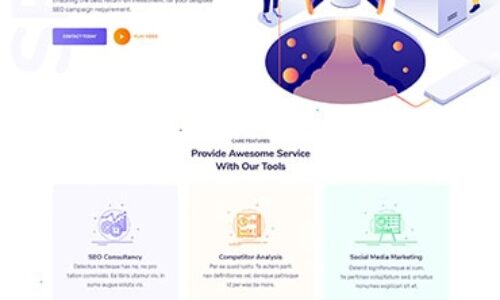
People use the internet every day to research products, read reviews and find local businesses. Ensuring your business appears in an organic search can help more customers find you.
An organic search result is the largest driver of all traffic to websites — so ranking as high as possible in a search is a must. Google recently launched the helpful content update, which focuses on people-first content. The update rewards content that’s informative to visitors and has a primary focus to answer questions.
Don’t stray too far from your expertise; your website should answer users’ questions and give them relevant information. Some ways to foster your site’s rankings are:

Update Existing Content
Your website’s content should be informative, engaging, and relevant to your target audience. Aim to create content that is unique, valuable, and easy to read. This will help to increase engagement and time spent on your site, which can have a positive impact on your search engine rankings.
Updating your existing content is a great way to improve your website’s search engine rankings and keep your content relevant and valuable to your audience. Here are some tips for updating your existing content:
- Conduct a content audit: Review your existing content and identify which pages and blog posts are outdated, inaccurate, or irrelevant. This will help you prioritize which content to update first.
- Refresh outdated information: Go through your content and update any outdated information, statistics, or references. This will help to keep your content accurate and relevant.
- Optimize for new keywords: Identify new keywords and phrases that are relevant to your content and audience. Update your content to include these keywords strategically in your headings, meta tags, and content.
- Add new information: Add new information, examples, or case studies to your existing content. This will help to keep your content fresh and engaging for your audience.
- Improve formatting and structure: Make sure your content is easy to read and skim by using subheadings, bullet points, and short paragraphs. This will make your content more visually appealing and easier to consume.
- Update images and videos: Update any outdated images or videos in your content. This will help to keep your content visually appealing and engaging for your audience.
Featured snippets are a type of search result that appears at the top of Google’s search results, providing users with a quick answer to their query. Here are some tips for structuring your content for featured snippets:
- Use subheadings: Break your content into sections with clear subheadings that reflect the main topics you’re covering.
- Focus on answering a specific question: Featured snippets are typically triggered by queries that start with “who,” “what,” “when,” “where,” “why,” and “how.” Make sure your content addresses a specific question or query that users might have.
- Use concise language: Keep your content concise and to the point, using clear language that’s easy to understand.
- Provide a summary or bullet points: Consider including a summary or bullet points that highlight the key points of your content. This can make it easier for Google to pull the relevant information for a featured snippet.
- Use tables or charts: If your content includes data or statistics, consider presenting this information in a table or chart format. This can make it easier for Google to display the information in a featured snippet.
- Use descriptive page titles: Your page title is the first thing users see in search results. Make sure it’s descriptive and accurately reflects the content on your page.
- Optimize your meta description: Your meta description is a short summary of your page’s content that appears in search results. Make sure it accurately reflects the content on your page and includes the keywords you’re targeting.
By structuring your content in a way that’s optimized for featured snippets, you can increase the chances of your content appearing at the top of Google’s search results and providing users with quick answers to their queries.

3. Create New Content Based on Low-Competition Keywords
Creating new content on low-competition keywords is a great way to increase your website’s search engine rankings and attract targeted traffic. Here are some tips for finding and creating new content on low competition keywords:
- Conduct keyword research: Use a keyword research tool to identify low competition keywords that are relevant to your industry and target audience. Look for keywords that have low search volumes but high intent, meaning that they are highly specific and relevant to your audience.
- Analyze your competition: Look at the content that’s currently ranking for your target keywords. Identify gaps in their content or opportunities to provide a unique perspective on the topic.
- Create high-quality, in-depth content: Create high-quality, in-depth content that provides value to your target audience. Use your target keyword strategically in your content, including in your headings, meta tags, and URL.
- Use long-tail keywords: Long-tail keywords are longer and more specific than generic keywords. They often have lower search volumes but higher intent. Use long-tail keywords strategically in your content to attract highly targeted traffic.
- Incorporate multimedia: Use multimedia, such as images, videos, and infographics, to make your content more engaging and shareable. This can help to increase your content’s visibility and attract backlinks from other websites.
- Promote your content: Once you’ve created your content, promote it through social media, email marketing, and other channels to attract traffic and backlinks.
By creating high-quality content on low-competition keywords, you can attract targeted traffic to your website, increase your search engine rankings, and establish your website as a valuable resource in your industry.

4. Track Metrics with Google Analytics
Google Analytics is a powerful tool for tracking the performance of your website and monitoring key metrics such as traffic, engagement, and conversions. Here are some tips for tracking metrics with Google Analytics:
- Set up tracking codes: Make sure you have Google Analytics tracking codes installed on all pages of your website. This will allow you to track visitor behavior and collect data on your website’s performance.
- Set up goals: Use Google Analytics to set up goals that track user behavior, such as purchases, form submissions, or downloads. This will help you understand how users are interacting with your website and measure the effectiveness of your marketing campaigns.
- Monitor traffic sources: Use Google Analytics to monitor where your website traffic is coming from, including search engines, social media, and referral websites. This will help you identify which marketing channels are driving the most traffic and adjust your marketing strategy accordingly.
- Track user behavior: Use Google Analytics to track user behavior on your website, including time on site, bounce rate, and pages per session. This will help you understand how users are interacting with your website and identify areas for improvement.
- Use segmentation: Use Google Analytics to segment your audience based on demographics, behavior, or other criteria. This will help you understand the different needs and behaviors of your audience and tailor your marketing and content strategies accordingly.
- Set up custom reports: Use Google Analytics to set up custom reports that track specific metrics or KPIs. This will help you quickly access the data you need to make informed decisions about your website and marketing strategies.
By tracking metrics with Google Analytics, you can gain valuable insights into your website’s performance, understand your audience’s behavior and needs, and make data-driven decisions to improve your website and marketing strategies.
Use Internal Linking
Internal linking is an important strategy for improving the user experience on your website, as well as improving your search engine rankings. Here are some tips for using internal linking effectively:
- Use descriptive anchor text: Use descriptive anchor text that accurately reflects the content of the linked page. This will help users understand what they can expect to find on the linked page and improve the accessibility of your content.
- Link to relevant pages: Only link to pages that are relevant to the content of the current page. This will help users find additional information that is related to their interests and improve the overall user experience.
- Use contextual linking: Link to pages in the context of your content, using phrases or sentences that provide additional context for the linked page. This will help users understand why the linked page is relevant and improve the flow of your content.
- Use a reasonable amount of links: Avoid adding too many links to a single page, as this can make it difficult for users to navigate and can negatively affect your search engine rankings. Instead, limit your links to those that are most relevant and useful to your users.
- Use a variety of link types: Use a variety of link types, such as text links, image links, and button links, to provide users with multiple ways to navigate your website and improve the visual appeal of your content.
- Update and maintain your internal links: Regularly review and update your internal links to ensure that they remain relevant and useful to your users. This will help to keep your website fresh and engaging and improve your search engine rankings over time.
Related Posts
5 ways to increase your site’s ranking
There are many ways to increase your website's ranking in search engine results, but here are five effective strategies: Optimize your content: Create high-quality, relevant, and engaging content that...


